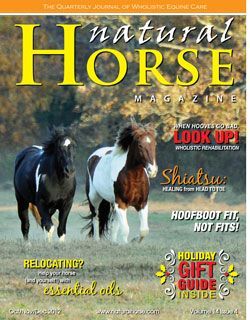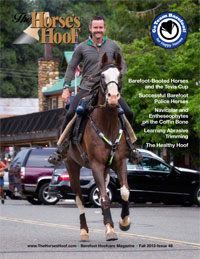I was browsing through Shawna’s blog this morning and ran across this. Thought it was apropos to post considering Chief’s terror over having his hooves handled. I concur with this article 100% and will be working on this when he gets to Barb’s if this is not addressed completely at Dave’s. It gives a good outline for helping any behavior resistance due to fear. 🙂 —
Handling a Feral Horse’s Feet
February 28, 2012 by Shawna Karrasch Filed under Ask Shawna, Husbandry Behaviors, On Target Training, On The Ground http://shawnakarrasch.com/blog/2012/02/28/handling-feral-horses-feet/
QUESTION:
Having recently purchased a very feral 5year old who had belonged to travelers, I too have found it extremly helpful to use food as a motivator. After 3 months i have achieved so much with this horse through the use of treats as a reward. He backs up away from the gate to allow me in, stands when asked, lowers his head to put the headcollar on. I will state that i do not feed from the hand the treat always goes onto the floor for him. He whinnys as soon as he hears my voice and comes to my call now at quite some speed sometimes. If im out he watch’s my ever move and follows me every where. I have never experience such a bond with a horse before in such a short space of time. I am now trying to tackle his main issue – his feet. Due to him being tethered by the method of tying his front two feet together i can not get near his feet, instead he trys to rear up, snatch them away, kick out. Any ideas on how to tackle this would be much appreciated.
RESPONSE:
Hi Paula, You are off to a great start. It sounds like you have developed a great bond with your horse. Now let’s get to those feet. Right now he has an unpleasant association with his feet being handled. The best way I have found to address this is to start with an area that is comfortable being touched. Our objective is to get him to associate having his feet touched as a good thing. First, I suggest doing what you can to set him up for success. When does he tend to be the quietest? After exercise? Does he have a place that he is more comfortable? Is a certain time of day better for him? Find whatever may help him to be more relaxed. Next, I would work him without a halter and lead rope. This ensures he has a choice and works to build a horses confidence. Also, in his past when they tethered his feet, I imagine they had him in a headstall with a lead rope. That means there would be an association between the headstall and being tethered. We will address that down the road but for now we want to avoid things that may trigger his defensive reaction.
To begin, I suggest touching him where he is comfortable being handled. Our goal is to move down his leg, so maybe you start at the top of the legs. I suggest choosing either working the front legs or the back legs. Pick the ones that he is the least sensitive about and alternate between the right and the left. If all is going well, wrap your hands around his leg so it feels like it is being held and massage the upper leg. You may reinforce him for good relaxed responses.
I should add that having a cue that tells him when he did something correct will be very helpful for this exercise. It will tell him that what he just did was correct and a reward is coming. It effectively bridges that gap between those two moments in time. Without the bridge signal he will associate what is happening when the food is delivered rather than his desired behavior. If you can’t feed in the middle of the activity, you miss the moment and it can lead to an unintentended result. Here is an example: Once upon a time a woman was working on teaching her young horse how to lift her legs. She was feeding a reward without using a bridge signal. She came to me as she was baffled why her horse was pulling her leg out of her hand and promptly putting it on the ground. I asked her when she was feeding the filly. She reported as soon as she was done. Here was the problem, she was feeding the horse for her foot being on the ground. The young horse put two and two together…the sooner my foot hits the ground the sooner I get reinforced. She was pulling her foot so she could do what got her fed. By adding a bridge signal, in this case a clicker, she could communicate that holding her foot was the behavior that was earning her a reward even though the food came when her foot was on the ground. The clicker worked as a bookmark to pinpoint a moment in time. I think in your situation it would help quite a bit. I have a three part video that will show you the clicker conditioning process (and some basic de-spooking work) if you want to learn more about teaching a bridge signal. Here is a link: http://despookingyourhorse.com.
I am going to use the term bridge signal (click) in the rest of the post. So, when he is standing quietly and relaxed for the upper leg move down a bit and repeat. The best way to do this in the beginning is in quick short sessions. Lot’s of reinforcement in short order. So maybe you leave it here for the first day. Start again and repeat, making progress. Never move to the next place until there is no reaction to the previous level. Always click on the behavior you want to see more of, in this case relaxation. This whole process starts with him relaxed and builds a good association with his leg being touched. As you work down the leg he will recall the previous exercise. When you get to his sensitive area (probably below the knee or hock) start just touching at first, don’t try to hold or massage yet. We have to take small steps (successive approximations) with the more sensitive areas. Slower is better. If he allows you to touch his leg and remains relaxed, click and reinforce. If he gets kind of tense look for the slightest relaxation then click and reinforce this relaxation. Slowly progress to more massaging and then eventually to lifting the leg and holding the leg/foot. Always click relaxation and softness during this process. Slowly increase the handling and manipulating of his leg position. I would also work on teaching him to lift his foot when you tap or point to his foot. This must be taught to be very soft, relaxed and not lifting it to high. Too much energy in this and you may be reinforcing his lifting/cocking his leg. Before I go on I want to add: ALWAYS keep safety in mind when dealing with a worried horses legs. Keep yourself positioned out of possible flying feet. Dealing with this situation can be dangerous and unpredictable. It may be best to have a qualified professional assist you, so please, if you are the slightest bit uncertain, get professional help.
When you have had success with the first pair of legs, move to the other pair and start the exercise from the beginning. Success is handling with no tension or worried reaction. When you have all feet handled without a halter, it is time to try the exercise with the halter and lead rope. This may alter things more than you expect. We have a tendency to think like humans but for your horse this might be a significant change. When this is good, move to different areas and then different times of day. If you have any setbacks just back up a bit with the training steps and remind him. I know this sounds as if l like a lot of steps but it will go faster than it seems. Depending on the individual horse, they tend to move fast through some parts and slower through others. Okay, Paula I hope this gives you some ideas of how to maximize the positive reinforcement training for dealing with your horses fears. If you have any questions or would like more help please don’t hesitate to ask. I would love to hear feedback, progress or comments.
ADDENDUM: Utilizing something to touch his legs could be a good intermediate step if he is sensitive to touch in general. This keeps you away from his feet but allows you to desensitize his legs to touch. It may still be a different story when you are manually handling his legs but it will be a good approximation. I find the lunge whip is a good choice since it is flexible and will not harm the horse if he kicks out. Someone (Tina) had suggested using a glove on a stick. She stuffs the glove so it keeps it’s form. I think that is a clever idea too.










